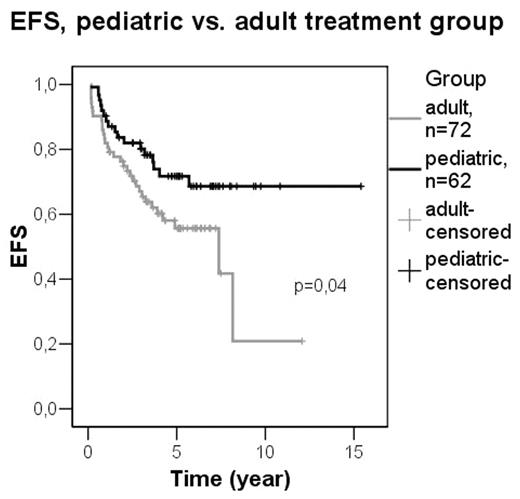Abstract
Background: Long-term survival in pediatric acute lymphoblastic leukemia has dramatically improved during the past three decades through intensification of therapy. Progress has also been made regarding therapy of adult ALL. Recent reports in the literature suggest better outcome on pediatric protocols, as compared with adult ones. In pediatric ALL, age over 10 years is a high-risk factor in many protocols. The arbitrary age limit of 16 years may not truly reflect the biologic differences in ALL between adolescents vs. young adults. The purpose of the present work was to evaluate the outcome of adolescents with ALL in Finland, treated on pediatric vs. adult ALL protocols.
Materials and methods: All patients aged 10–25 years diagnosed with ALL during 1990–2005 in Finland were included. There were 120 patients (aged 10–16 yrs) treated on pediatric common Nordic (NOPHO) protocols with a total duration of 2 yrs, and 100 patients (aged 17–25 yrs) treated on Finnish National ALL adult protocols with a total duration of 3.5 yrs. In total 15 underwent allo-SCT in first remission. Data had been collected to the pediatric Nordic NOPHO database, as well as to the Finnish Leukemia Group ALL database. Events were defined as death, relapse, or second malignancy.
Results: The 5-year EFS was 68 % for children (n=62) and 55% for adults (n=72) (p=0.04), and the 5-year OS was 75 % for children and 68 % for adults (p=0.075), respectively. When only patients treated with conventional chemotherapy were included (stem cell transplant recipients in 1CR excluded), the 5-year EFS was 65 % for children (n=53) and 55 % for adults (n=66) (p=0.09), and the 5-year OS was 80 % for children and 65 % for adults (p=0.09), respectively. Regardless of protocol, EFS in the age group of 10–15 years was 74 % and in the group 15–25 years 57 % (p=0,06).
Conclusions: EFS regarding all patients was better on pediatric than on adult protocols. All the other comparisons reached statistically only a trend level. The difference in outcome between pediatric and adult protocols in Finland is less clear than reported elsewhere. Age seems to be a prognostic factor also in the adolescent age groups. The non-transplanted patients seemed to have a better outcome, suggesting that those with higher risk probably ended up with transplant. Although therapy is an important risk factor, our further analysis of cytogenetic features including CGH array may reveal other risk factors that may turn out to be even more powerful.
EFS, pediatric vs. adult treatment group
Disclosure: No relevant conflicts of interest to declare.
Author notes
Corresponding author


This feature is available to Subscribers Only
Sign In or Create an Account Close Modal